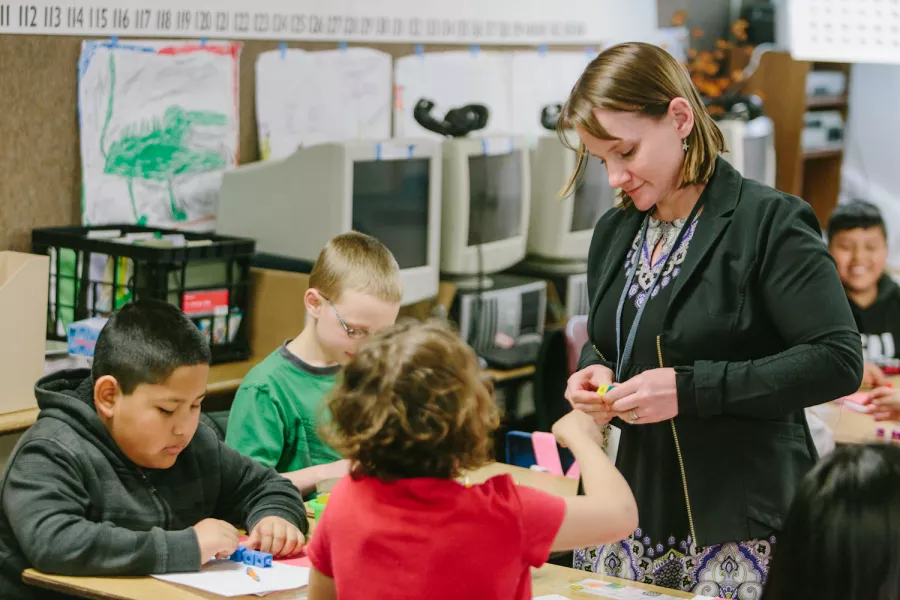Bustling Allen Elementary School might be attractively plunked in the scenic heart of Skagit Valley farmland, but it can be a challenging place to start a teaching career.
Eighty percent of the K-8 school’s kids are poor enough to qualify for free or reduced lunch, and at least 40 percent speak a language at home other than English, including the Mexican indigenous languages Mixteco and Triqui. A migrant labor camp across the street contributes up to 60 students.
Teacher turnover is not uncommon, with 10 new hires necessary for the 2015-2016 year. Other districts can offer better pay and classes filled with kids from middle-class families.
But to the graduates of a pioneering Western program called Pathways to Teaching, this is their dream job. Three new graduates began their teaching careers at Allen last fall especially prepared to reach and inspire their pupils.
They represent Western’s determination to come to grips with the nation’s fast-changing racial and cultural balance.
“We’re at Allen because the Pathways teachers are exactly the teachers these students need,” says Maria Timmons Flores (’82, Psychology; ’86, M.Ed.), director of the Pathways program at WWU’s Woodring College of Education.
An example is first-grade teacher Luz Lopez (’15, Language, Literature and Cultural Studies), 33. She and fellow Pathways grad Leslie Bunzel (’15, Language, Literature and Cultural Studies) are the school’s sole Latina teachers. In a school where two-thirds of the students are Latino, they’re role models who communicate with their classes in both English and Spanish.
“It’s a challenging but rewarding experience for me,” says Lopez, a former instructional assistant who needed Pathways’ help to become an accredited teacher. “I wanted to come here. I feel I can make a difference.”
Immigration has become a fiery presidential campaign issue this election year. Even some third-graders of another Allen Pathways teacher, Brittyn Cantrell (’01, Environmental Education; ’15, Language, Literacy and Cultural Studies), have worriedly mentioned Donald Trump.
But beyond the national debate is the practical issue of educating 6-year-olds whose parents and grandparents are vital to Skagit planting and harvesting and have become a vital part of the community fabric. By law, all children in the United States are entitled to K-12 education, regardless of their own or their parents’ national origin or immigration status. As of 2014, the U.S. Department of Education estimated there are 840,000 immigrants in K-12 American classrooms and 4.6 million who are English learners.
Traditionally, Timmons Flores says, teaching has been a career choice for white, middle class women. The result is that while 43 percent of children in Washington’s classrooms are students of color, 93 percent of their teachers are Anglo.
“Many teachers don’t have a window into the lives of their students,” Timmons Flores says. Students of color, especially those from farm worker families, might be poor, come to school hungry, and have migratory lives. There are usually youngsters at Allen Elementary with a parent held at Tacoma’s Northwest Detention Center, a private immigration prison run for U.S. Immigration and Custom Enforcement.
Despite his efforts to resolve the legal status of millions of immigrants, Barack Obama has overseen more deportations than any American president, about 2.4 million in his first seven years in office. And Obama’s recent executive order to defer deportation for parents of U.S.-born children faces an uncertain future before the U.S. Supreme Court.
But Allen Elementary School is a refuge, made stronger by these new WWU-trained teachers who understand the kids’ emotional needs. They come prepared to connect classroom learning to the knowledge the kids bring to school, Timmons Flores says, and to support the students’ learning in two languages.
“They are reminded that they are safe here,” says Cantrell, 40, who doesn’t speak Spanish but is qualified to teach English language learners, thanks to the Pathways program. That means she is experienced in reaching kids for whom English is their second language.
“They want to be here,” Cantrell says. “They want to see their friends and play.”
Like Lopez, Cantrell was an instructional aide for eight years but couldn’t afford to quit work for a full-time Woodring program to earn full teacher certification.
Pathways provided a two-year alternative program of classes, experience, and financial support for an initial cohort of 15 Western students. Ten identify as Latino, 11 have experience teaching in a second language, and half already had a bachelor’s degree. Eight are from either the Burlington-Edison or Mount Vernon school districts and have from three to 14 years of experience working in Skagit Valley schools.
All 15 received $8,000 a year in scholarship money through a grant from Washington’s Professional Educator Standards Board to develop teachers in shortage areas, such as bilingual education, if they committed to teach at least two years. And all 15 graduated in spring 2015 and began work as teachers the following fall.
Addressing the achievement gap
Lopez grew up with a migrant farm family in Eastern Washington’s Mattawa. Now a first-grade teacher at Allen Elementary, she understands where her students come from. They, in turn, have a first-grade teacher who looks like them.
“I always reaffirm the positive,” Lopez says.
Historically, students of color, low-income students and those learning English as a second language have not had the same opportunities to learn and succeed as many of their peers, says Timmons Flores, an associate professor of Elementary Education whose area of expertise includes supporting students from migrant families. Officially this is known as the achievement gap, but, “The achievement gap is an opportunity gap,” she says. These kids are capable of excelling, she says, but neither teacher education nor schools have prepared teachers with the professional knowledge to close the gap.
This kind of “equity pedagogy,” or a commitment to close the opportunity gap, is an important characteristic of all teacher training at Woodring, Timmons Flores says. And the Pathways program seeks to bring to the teaching profession those who have experience living or working in diverse communities — experience that could also be put to use in closing the gap.
But many Pathways student-teachers have families to support and didn’t have the means to leave work for a full-time teaching program, Timmons Flores said. “None of them would have become teachers in traditional programs,” she says.
Lopez is a good example. She grew up wanting to be a teacher and, having been born in California, she has dual U.S. and Mexican citizenship.
But when she married in Mattawa, she didn’t have the opportunity to go to school. She had two kids, got divorced, and moved to Mount Vernon to be with her extended family. She eventually went to work as an instructional assistant, but as a single mom there wasn’t a practical means to go to WWU for a teaching degree.
“It took me many, many years just to get my AA degree” at Skagit Valley College, she says. “It was like, one class a quarter.”
Now there is help for Skagit students with Burlington-Edison High School’s Recruiting Washington Teachers program to identify promising students and encourage them to get a degree. And Maestros Para el Pueblo is a partnership among Skagit Valley school districts, Skagit Valley College and Woodring to support young people to become instructional assistants and, ultimately, teachers.
Another new Pathways alumna is Berenice Rodriguez (’09, General Studies; ’15, Language, Literacy and Cultural Studies), who began life in Mexico and began third grade at La Conner Elementary when her family moved to the United States for farm work. She completed a degree at Western and dreamed of becoming a teacher, but was ineligible for a teaching certificate because of her undocumented status.
Like many other “DREAMers,” Rodriguez got a college degree in hopes that immigration reform such as the proposed DREAM Act would one day allow her to put her education to work in the classroom. In 2012, President Obama’s Deferred Action for Childhood Arrivals program made it possible for her to get a job as a teacher’s aide at Lucille Umbarger Elementary School in Burlington. Then scholarships from Woodring and the Skagit Valley Foundation enabled her to attend the new Pathways program to achieve certification. She now teaches second-grade at Burlington’s Westview Elementary, a dual-language school.
Timmons Flores is recruiting a second cohort of 20 teacher candidates who will begin in August of this year. A $300,000 grant from the Professional Educator Standards Board will provide $8,000 scholarships for the participants.
What binds these educators is a combination of ambition and passion. They aren’t intimidated by the sometimes challenging situations some of their students face at home. And they see and value the strengths that their students and families bring, and are prepared with the knowledge and ability to support their students’ success, Timmons Flores says.
Take, for example, Allen’s family support network. Many families at Allen, while they care deeply about their kids’ education, work long hours without a car and can’t come to PTA meetings or parent conferences. Some students start late in the fall and leave early in the spring because of field work. So teachers have adapted their outreach so more families can participate. They offer meal programs that can include family members and hold community celebrations of student work and success. Families who must move for work may keep their kids at Allen as a home school. After-school and summer programs take place at times when parents are working; these programs tend to have more Spanish, Mixtec and Triqui speakers. School staff members are also working to create ways for families to have a more active voice in decisions.
Shifting demographics
Each wave of American newcomers — Germans, Irish, Italians, Chinese, Japanese, and more recently Somalis and Syrians — has faced resentment and discrimination. Despite conservative fantasies about deporting millions of undocumented workers and their kids, these students are almost undoubtedly here to stay, Timmons Flores says. Their success is in our national interest.
The Latino influx is the result of complex market forces. Migrant labor has long been welcomed to sustain farming and services. Latin American rural poverty fueled by new policies such as the North American Free Trade Agreement drove more people north. Many laborers once preferred to return to Mexico each winter, but as the border tightened they simply stayed and eventually smuggled in their families. Trying to keep people out was actually keeping them in.
According to the Migration Policy Institute, by 2013 there were more than 41 million foreign-born immigrants in the U.S. — four times as many as in 1970 — and nearly half were of Latin American origin. The state of Washington had nearly a million foreign-born in 2014, or 13.4 percent of the state’s population.
Add the foreign-born to their U.S. born children, and the national total is 80 million, or about a quarter of the American population.
That’s the demographic reality, and that’s what Pathways to Teaching is trying to address. “I think it’s a win-win,” says Timmons Flores. Aspiring teachers get a practical way to achieve their dream, students of color get teachers who are role models, and society gets better-educated kids.
But numbers only tell part of the story. Teaching is also a labor of love, and first-year participants like Lopez, Cantrell, and Rodriguez say they put in 70-hour weeks for relatively modest pay. Why?
Lopez shows a basket of apples she is accumulating from grateful students and a bulletin board with letters from students. “Dear Ms. Lopez,” first-grader Lauren laboriously penciled. “I like you as a teacher.”
“The reward is hugs and smiles,” Lopez says. And she smiles herself.

